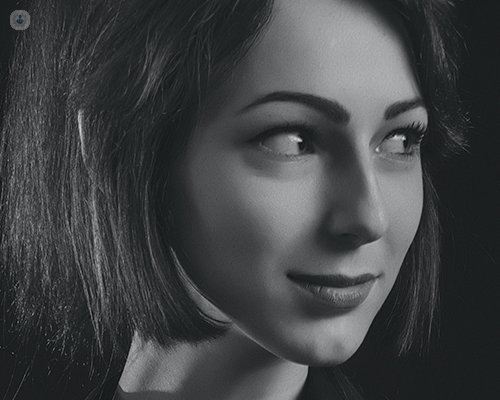The key approach to successfully treating dark circles
Autore:Peri-orbital or ‘under-eye’ dark circles can be a source of reduced confidence but, thankfully, there are several solutions. Learn from leading consultant plastic surgeon, Mr Jonathan Britto, about why some people have dark circles and how they can be successfully treated.

Is it safe to treat dark circles?
Periorbital dark circles reduce confidence in appearance for many men and women. It’s a common problem in people of colour, such as Afro-Caribbean’s and South Asians, as well as the peoples of Southern Europe.
The good news is that dark circles can be successfully treated when the correct procedures are selected and administered safely and effectively within a multi-disciplinary team approach.
Why do people have dark circles under their eyes?
The key to successful treatment lies in the diagnosis. There may be a single cause or, more commonly, a combination of several factors. Addressing each one in turn in a collective treatment plan brings collective improvements and importantly, happiness in the outcome of treatment.
The three principal causes of dark circles are:
- Increased pigment from the melanin-producing cells of the skin (‘melanotic’)
- Increased pigment from blood flow through the skin (‘vascular’)
- An imbalance of volume from skin, muscle, or fat (‘anatomical’).
General contributory causes include:
Attention to general health and diet is therefore always key.
Why do people seek treatment for dark circles?
Dark shadows around the eyes often include the skin of the upper eyelids (under the eyebrow), to the upper eyelash line, around the outer corner of the eyelids and from the lower eyelash line to the upper cheek. The dark pigment, be it melanotic or vascular, creates an unwelcome appearance of fatigue and premature ageing.
Volume difference is also a reason. Too much volume (eyebags) or too little volume (skeletonisation) creates a ’ski slope’ in the midface, where the ‘valley’ collects shadows and contributes to the tired aged appearance. This negative impact on well-being and quality of life has an adverse impact on confidence and consequently, patients resort to wearing thick-rimmed spectacles or heavy-handed makeup.
What treatments are available for patients?
A multi-disciplinary approach is key!
- For melanotic causes, a cocktail of topical medications can be prescribed to interrupt the melanin pigment-forming pathways and reduce the deposition of dark pigment. Anti-oxidants act as free radical scavengers and reduce pigment density in the skin, and reduce pigment deposition and optimise skin health. These preparations all come with a word of warning - if not administered correctly, they can make the condition irreversibly worse, so as with all the treatment methods, they must be prescribed and monitored by a medical professional to achieve the long term results and optimise skin health.
- For vascular causes, where there is increased blood flow or hemosiderin deposits (yellow/brow pigment in the blood) in the skin, strategies are directed to reduce blood flow by highly selective diathermy (a technique involving the production of heat in a part of the body), laser approaches and topical medication such as heparin based creams. When there is a vascular lesion present, surgery may be the chosen option in which excision and reconstruction provide beautiful aesthetic outcomes.
- For anatomical causes (eyebags or skeletonisation), the surgical restoration of volume balance offers the best outcome. This restores the youthful light reflex from the midface and removes the shadow whilst retaining natural facial features. Such procedures hide the scar beautifully, or can leave no visible scar, and will have a long-lasting effect on natural confidence.
What are the procedures and recovery period like?
Surgical blepharoplasty takes 1-2 hours under ’twilight anaesthesia’ and is a day case procedure. Recovery is swift and going back to work is possible within 7-10 days. Regular mentored care at home and access to follow up care at the clinic is available throughout recovery.
Combination treatments with anti-pigment topical care and/or surgery offer superior results. Topical care is carefully planned before surgery and should be given for at least three months to achieve a stable de-pigmentation and reduction of dark circles. Lasers, chemical peels and topical creams can be used before and after surgery. Deep medical chemical peels are extremely useful outpatient procedures in the treatment of dark circles and, in some cases, can be performed at the same time as surgery.
Other treatment methods that have proven extremely useful in some cases include surgical micro-fat transfer, which gives both volume and stem cell therapy to the melanin pathway. Dermal filler, such as hyaluronic acid (a very fine gel filler), is useful in some instances for the non-surgical management of volume deficiency.
In summary
The successful management of periorbital dark circles is very satisfying for the care team and the patient alike. It takes time and care to build trust and the good relationships that ensure positive outcomes.
Furthermore, expert knowledge and understanding of the primary cause(s) are crucial to the success of the treatment. Combination approaches with non-surgical methods such as topical medication and surgery combine for long-lasting rejuvenation and the reduction of a fatigued and ageing appearance. As a consequence, very satisfying and happy results are delivered.
Mr Britto brings the art and science of 25 years of study in facial development and restoration to his craft. Visit his profile to learn more and book an online or face-to-face consultation.


